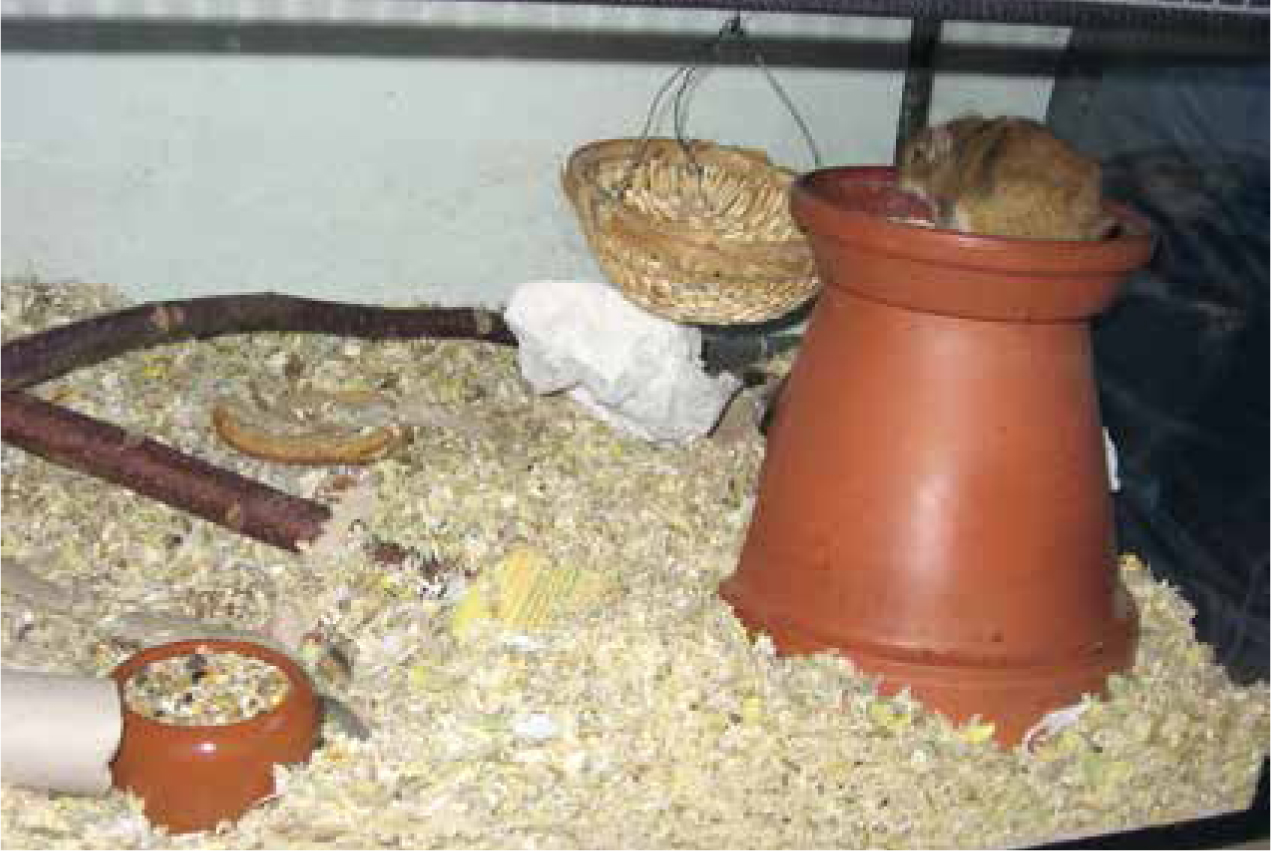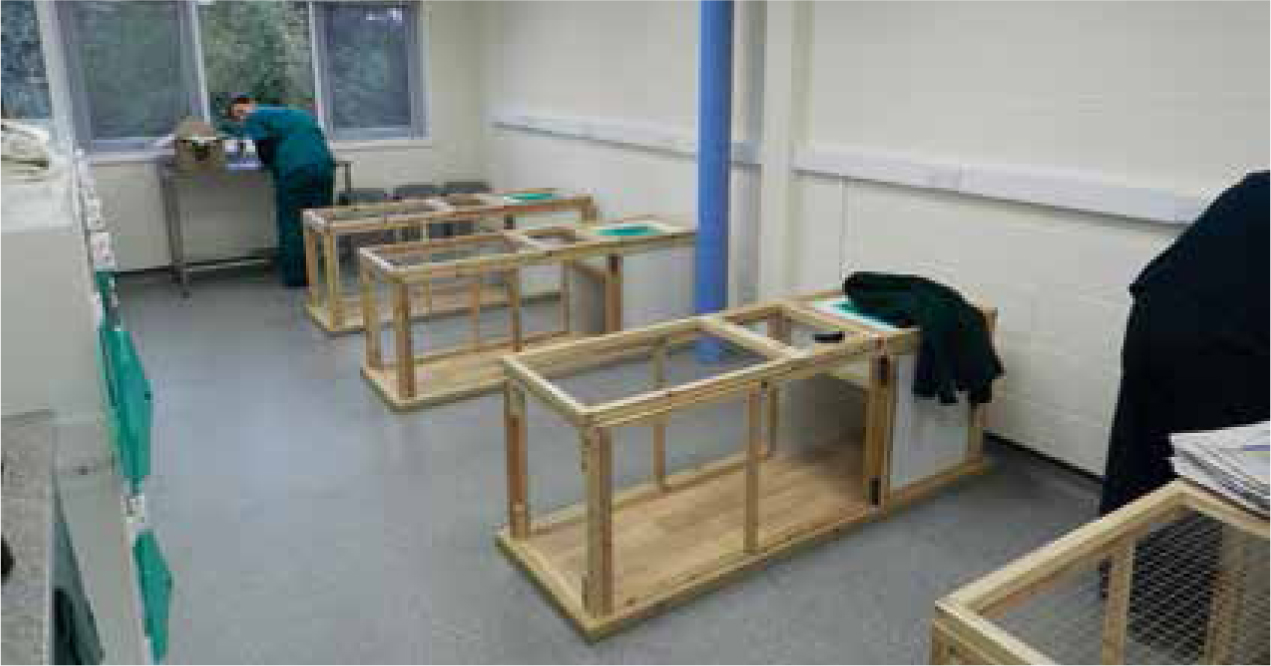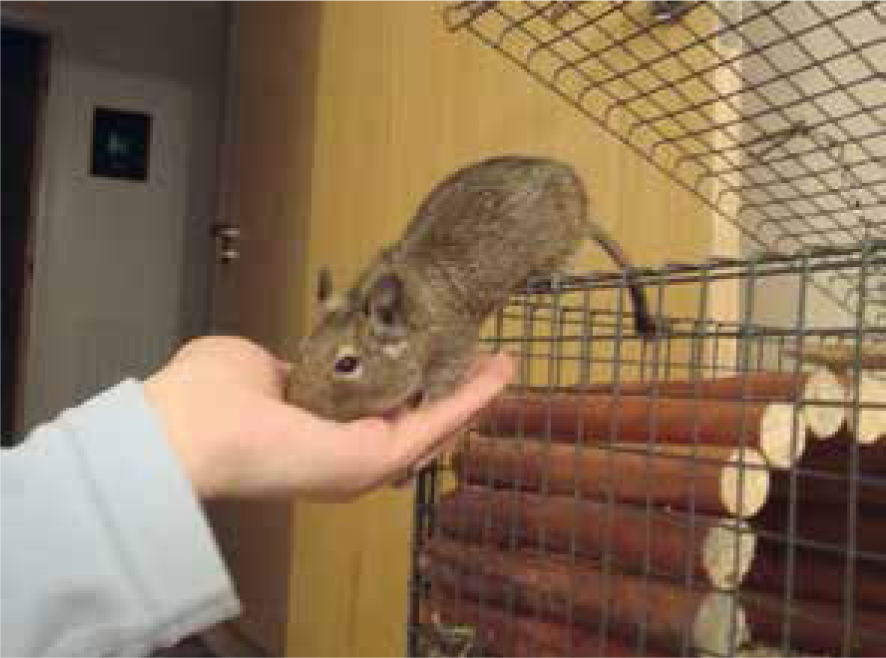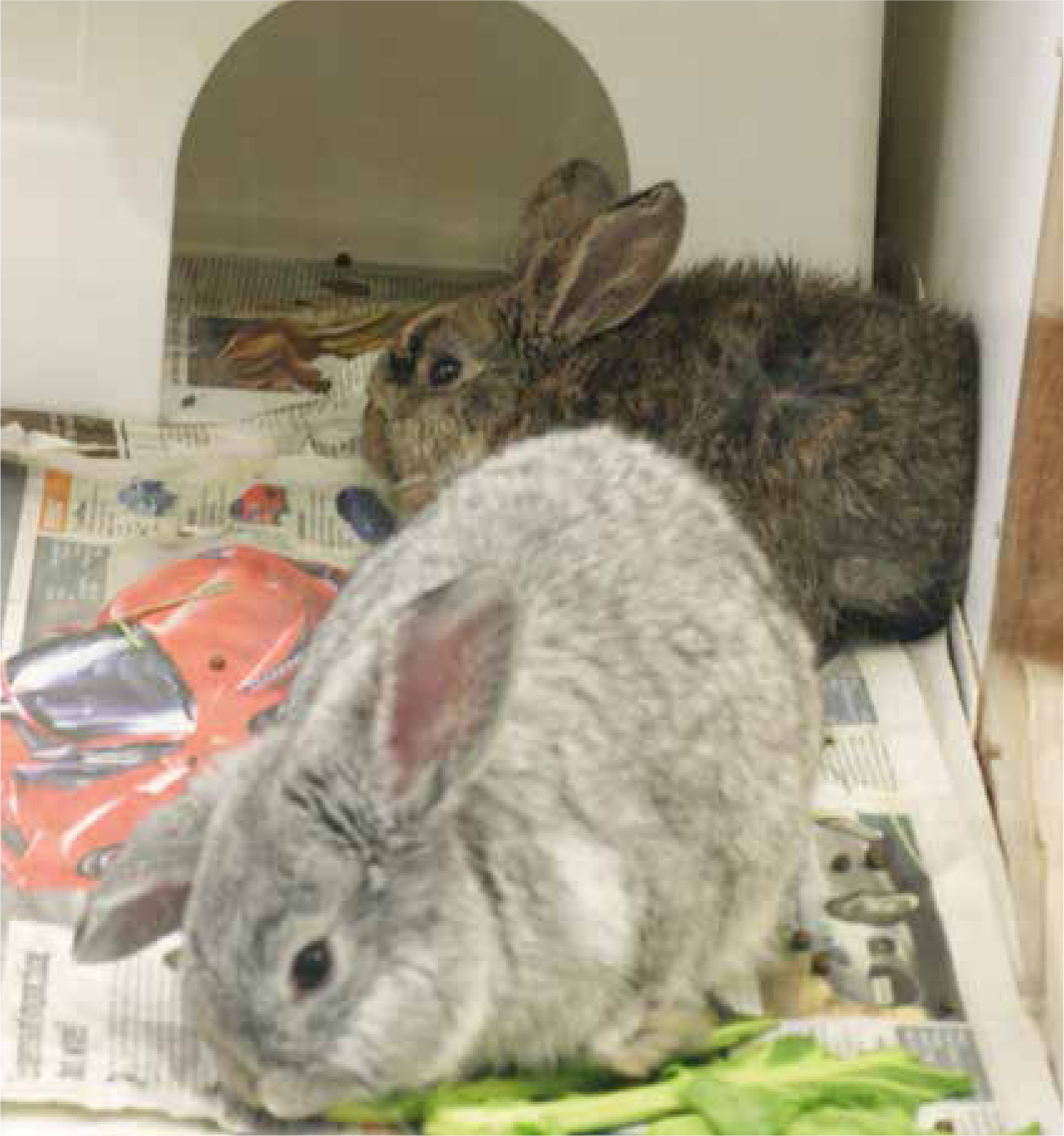The term ‘small mammals’ encompasses a wide range of species. Each has its own environmental, nutritional and social grouping needs. They also have species-specific activity rhythms, behaviours and communication signals. Given this, and word limitations, this paper only provides a limited introduction to a few general considerations.
Small mammals comprise a large sector of the UK pet population, with rabbits, guinea-pigs and hamsters alone accounting for 1.7 million animals (PFMA, 2017). Species including degu, chinchilla, rats, mice, gerbils, chipmunk, racoons, meerkats, pygmy hedgehogs and ferrets are not included in this estimate. Through the auspices of laboratory and veterinary, psychology and ethology research, advances are being made in how their physical health and welfare should be provided for (Meredith and Delany, 2014; Yeates, 2017), and in knowledge of their natural behaviour and cognitive abilities (Wolff and Sherman, 2007; Wynne and Udell, 2013; McBride, 2017). Yet, the translation and transmission of this knowledge to the public is not as effective as it should be, as evidenced by the PDSA (2017) survey which found that pet rabbits are frequently neither housed nor managed appropriately (PDSA, 2017a). If this is the case for the rabbit, about which there is a wide range of easily available information, including an annual UK Rabbit Awareness Week, the situation for less publicised species is likely to be worse and potentially exacerbated as the vast majority of these individuals will never be taken to a veterinary surgery, even if they are ill or in pain.
This is not because owners do not care, but due to a lack of knowledge about signs of stress, illness and pain of these species (Magnus and McBride, 2017a; McBride, 2017) and various long-held, if inaccurate, beliefs about the needs, lifespans and availability of veterinary care (McBride and Magnus, 2017, Magnus and McBride, 2017b). There is an important educational role here for veterinary nurses. However, many veterinary professionals have a limited knowledge of these species and may not know how best to advise prospective and current owners. Additionally, this limited knowledge may mean they do not take adequate practical steps to help reduce stress, and thus facilitate recovery, when these animals come to the surgery. It is the author's aim to help the reader rectify this through a brief exploration of four aspects of these animals: size, sight, sound and scent, and how these relate to sources of stress.
With the notable exception of the ferret, the species considered are small prey mammals (SPM). SPM are crucial to the food chain, they are Mother Nature's take away meal providing food to most predator birds, mammals, snakes and other reptiles. They are hunted above and below ground, even in the comparative safety of their underground homes. Indeed the elongated body of ferrets, weasels and stoats is an evolutionary adaptation enabling them to hunt efficiently below ground. This can be seen in photographs and videos of mouse-pouncing foxes, or when cats mercilessly play with their prey before finally delivering the kill bite to the neck. Some predators have evolved to become specialists, hunting very few species. In the modern world this can be disastrous, a case being the Iberian (Spanish) Lynx and the rabbit. Over millennia these two species evolved together in the Iberian peninsula (southern Spain and Portugal), the lynx developing specialist hunting behaviours resulting in it being dependent on rabbits for 90% of its diet. However, over the last 60 years there has been extensive loss of habitat to human building encroachment. This, combined with the recent devastating decline in the rabbit population due to myxomatosis and rabbit viral haemorrhagic disease, means the Lynx is now on the brink of extinction (Dybas, 2014).
Understanding how being both small and prey influences an animal's view of the world is central to finding practical ways to reduce stress. The four Ss (size, sight, sound and scent) and related stressors are discussed below.
Size
Most animals seen in veterinary practice are substantially smaller than the professionals caring for them. While true for dogs and cats, it is even more so for the small mammals that are only a few centimetres in height. The adult world view is from around 1.25–2 m depending on the individual's height; how height changes the way the world is perceived is rarely considered, be that children or animals, nor what small animals see from their accommodation, nor how being lifted (or lowered) may be stressful, not only because of the movement involved, but because of how perceptions are changed. The implications of being small are not always obvious. Box 1 provides a simple fun exercise that can help professionals and owners start to understand the animal's view of the world around them.
In fact simply being moved, as opposed to choosing to move oneself, is stressful. People too would be stressed if their home suddenly shifted: they were not warned; the movement is erratic; they do not know where they are going nor how long this will last. Those who have been involved in earthquakes or tsunamis can give testament to this.
It is known that transport of farm animals is very stressful, yet this is often ignored when it comes to small animals. Research shows that simply moving their home cage across the room where they normally live is so stressful to rats that it causes them to remain hyperthermic for over an hour (Dallman et al, 2006). For some, the stress of being moved may be compounded by the additional stressor of an unfamiliar carry cage.
Stress puts animals on the alert, vigilant for any threat. For all animals this may lead to stress-induced analgesia (Butler and Finn, 2009), meaning diagnostic manipulation and examination may be incorrectly interpreted. Indeed, hiding pain and weakness is a survival technique of prey species. Stress also interferes with recovery from illness or surgery. One way to help minimise stress is to keep animals in a familiar cage and keep the environment as familiar as possible. If a carry cage is used, owners should make this part of their pet's normal home environment, lined with comfortable bedding and associated with special food treats. In the clinic, move SPM as little as possible and as far in advance as practicable, so they have the opportunity to recover from the stress of relocation. For example, can animals be moved to operating rooms an hour or more ahead of surgery? Does this mean asking owners to bring their pets in early on the day or moving SPM operations to later in the day? Also, do ask about the animal's home accommodation and management (Figure 1). Reducing the strangeness of the veterinary ward accommodation will help reduce stress (McBride, 2013), for example, by being able to provide the animal's normal substrate, diet, drinking arrangement (does it use a bowl or bottle at home) and importantly, somewhere (dark) in which it can hide from view and feel safe (Figure 2). Of course, animals that have been well socialised and handled, and thus trust and are confident around people (Figure 3), are going to cope better with the stress of visiting the surgery. It is known that the small animals recognise individual people (Davis and Bal-four, 1992), and a cloth held by and thus carrying the smell of a trusted, familiar (their favourite) person may also help keep animals calm.



Sight, sound and scent
Most of these species live underground or in rock crevices sheltered from daylight, emerging to forage in evening and early morning when light is low, or in the darkness of the night. Some, like guinea-pigs, are diurnal but even these live in the dappled deep shade of long grasses. Basically, light is a serious stressor for small mammals. Light levels that people find not only acceptable but necessary to undertake normal behaviours, they find highly aversive and painful. It is advised that their accommodation is lit by non-flickering light of around 210 lux (McBride, 2017). A separate screened area of the waiting room with a covered place to put carry cages can reduce light exposure and visual contact with predators.
SPM hearing ranges overlap much of humans and extends beyond it into the ultrasonic range. Here is another research exercise that can be undertaken to investigate the level of ultrasound in the surgery. This can easily be done by purchasing a bat detector, or asking the local wildlife or bat conservation group (www.bats.org.uk) to lend the practice theirs. Ultrasound is emitted from dental cleaners, when metal touches metal as in putting instruments into dishes, from water running from taps, machine or ceiling fans, and from laptops and computers. Even fluorescent lights emit ultrasound, so consider if these are really needed on in animal wards. There are also all the other noises: people walking and talking, doors opening and closing, dogs barking, cats meowing, cars outside etc. etc. Realising just how noisy the human world is can be both enlightening and disturbing. Given how acute the hearing of many animal patients is compared with that of humans, being unable to escape from loud sonic and ultrasonic noises must be extremely stressful.
Can anything be done to reduce this? Obviously talking quietly and minimally, and shutting doors gently is a start. Moving slowly and deliberately usually means people are quieter, important around any stressed animal, and especially so when they cannot see from their cage where the noise is coming from. Consider if animals should be housed in plastic or wooden cages rather than metal; on shelves or the floor as opposed to being placed in metal racks. Ultrasound does not penetrate solid surfaces, so providing sound barriers around small mammal cages in addition to dark (not translucent!) solid walled tunnels and resting areas will give the animals freedom from the stress of light and ultrasonic noise and means they can use the whole of their accommodation during the day to rest in, groom, socialise or simply move around.
Smells too can be stressful. The strength of a predator's scent indicates that it is nearby, or has been recently, and is a signal to be vigilant (Apfelbach et al, 2005), with associated stress-induced analgesia and behaviour change, including reduced eating especially if the food source is exposed (Orrock et al, 2004). This vigilance effect is exacerbated if the scent is from a male, and it is known that the gender of a scientific researcher can affect the data collected (Sorge et al, 2014). Veterinary surgeries contain a wide array of predator scents: humans, cats, dogs, ferrets. Simple strategies can help, including housing SPM in a separate room, washing hands between handling predators and handling SPM or SPM caging. It may also be preferable for female staff to be the first choice to see and care for these patients.
Scent is also central in the identification of group members. This is an important consideration, especially when working with territorial species that do not take kindly to intruders, such as chinchilla, rabbit, gerbil and degu (Tynes, 2010). Not doing so when an individual is brought to the surgery can lead to fighting and permanent breakdown of relationships when it is returned to the group. This is simply because it no longer has the group smell and thus is not recognised as a ‘friend’ but as a foe to be driven out of the vicinity. Fights can have dire outcomes, with potential for serious injury, and it is likely that an animal will end up living alone or being rehomed. While this does not always occur, when it does it is extremely distressing to owners. Prevention is better than regret. Advise owners to bring the whole group to the surgery (Figure 4). If one animal is handled or operated on, then steps need to be taken by veterinary staff to ensure the scents are distributed throughout the group by handling them with the same gloves, or gently rubbing them with cloths that have been in the theatre and thus impregnated with the same smells. A further precaution to maintain a consistent scent profile, especially if cagemates have been left at home, is to share used bedding from the patient's cage with the home cage and vice versa. Scent swopping with cloths should be done before any re-introductions are undertaken (Campbell, 2010; Buseth and Saunders, 2015).

Research, knowledge, outreach — how to have ‘stress-less’ animals, staff and owners
Clearly, understanding what is stressful to animals is essential to owners as well as veterinary staff. Evidence shows that some methods of picking up or holding animals be that for simple interaction, health checks or delivering an injection can radically increase the levels of stress and pain (McBride, 2015; Stuart and Robinson, 2015; Roughan et al, 2016). There is a myth that small mammals do not clearly show when they are stressed, ill or in pain. This myth no doubt comes from the difference in size between these animals and humans, and lack of considered observation of these little animals. Not only can illness and stress be detected by changes in behaviour, body posture and vocalisations (Magnus and McBride, 2017ba), but as in humans and other species, small mammals use facial expressions to indicate how much pain they are feeling. These expressions are known as facial grimaces. Facial Grimace Scales have been developed for a range of species including human babies, horses, pigs, cats, rabbits and mice (Langford et al, 2010; Keating et al, 2012; Lonardi et al, 2013; Dalla Costa et al, 2014; Holden et al, 2014; McBride, 2017). Grimace scales for rats, mice and rabbits are freely available to down load from the NC3Rs website (see Further resources below).
It is important that veterinary staff research the species they are working with, both in terms of veterinary medicine and also the species’ natural habitat and behaviour. It is also imperative that appropriate up-to-date information is shared with owners. Only in this way can they be enabled to meet the physical and psychological needs of their pets and have excellent, friendly, rewarding relationships throughout the animal's life. However many owners are not aware of their pets' needs (PDSA, 2017a) and every year tens of thousands of rabbits and SPM are given up to rescue or interactions with them are reduced to a minimum until they die, often with shortened lifespans (Copping, 2009). This may be because the owner loses interest, or, perhaps more likely, the animal is showing undesirable behaviour, especially aggression. Aggression may be due to fear of being handled, a lack of mental stimulation or illness and pain. It is also known that simply keeping these pets in brightly lit or noisy rooms causes sleep problems that, within just a couple of weeks, can lead to ill health (Castelhano-Carlos et al, 2009) and potentially problematic behaviour, including aggression.
Veterinary staff have ethical and legal obligations to do their best to reduce stress for animals they work with directly. These ethical obligations extend to doing one's best to enhance the lives of animals that may never be seen in the veterinary surgery, including birds, reptiles, amphibia, fish, even invertebrates and, of course, the small mammals. This can be done by reaching out to current and potential owners. Outreach in the form of posters and leaflets in the surgery, giving talks to schoolchildren and others are all ways of spreading good, accurate information. Reputable organisations such as the Blue Cross, PDSA, RSPCA and Rabbit Welfare Association and Fund (RWAF) have many useful downloadable resources, including e-learning resources for prospective owners (PDSA, 2017b).
Conclusion
It is hoped this article has sparked an interest to find out more about these fascinating and frequently underestimated creatures with which our human clients choose to share their homes. The reader may wish to look at the author's paper (McBride, 2017) which contains two summary tables of key points: to improve SPM behavioural welfare in veterinary practice, and to assist owners to meet SPM welfare needs. There are many other excellent, scientific sources of information in books and journal. In addition to the reference list, some sources of further information and resources are suggested for readers and their clients.

